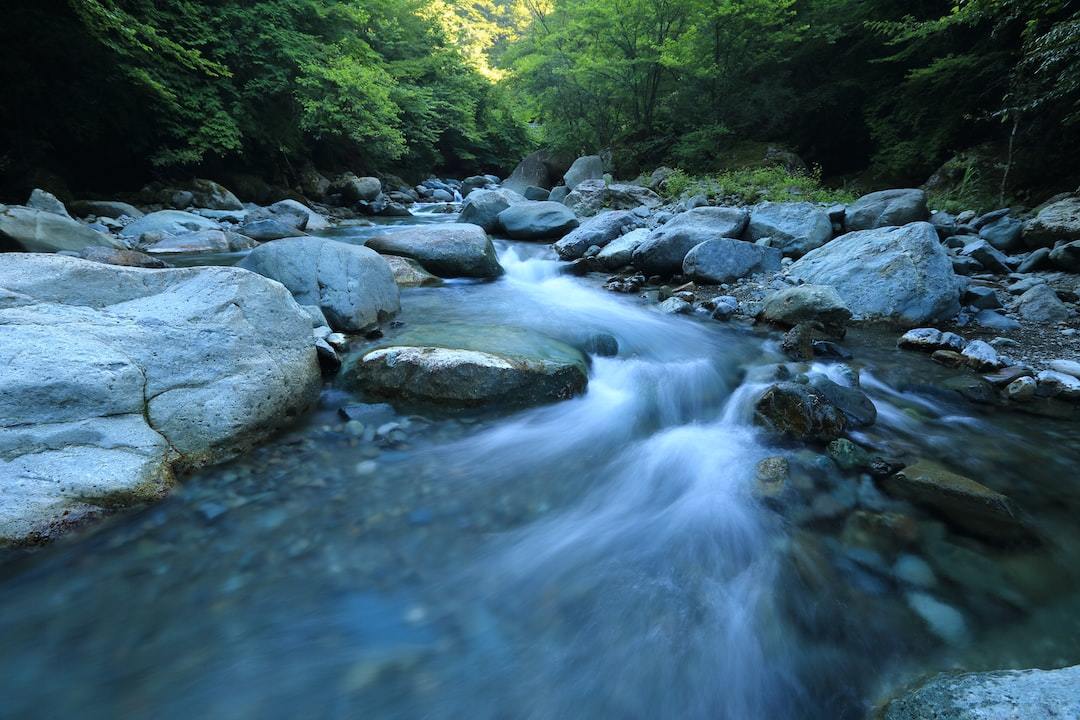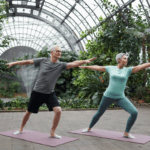Coming Soon: E-book about Kundalini Yoga - Sign up here to be among the first to get it!
So, you’ve heard about vinyasa yoga, huh? Maybe you’ve been told it’s a flow that connects movement and breath. Or perhaps someone’s described it as a ‘moving meditation’ – poetic, right?
But when the rubber hits the mat…what exactly is vinyasa yoga? Is there more to this style than just moving gracefully from one pose to another like some kind of ballet dancer turned yogi?
Intrigued yet mystified by these sun salutations and downward-facing dogs everyone keeps talking about, you decide it’s time for answers.
Let’s embark on this journey together, demystifying what vinyasa truly signifies – it goes beyond just the poses. We’ll delve into its deep history, rooted in Ashtanga Yoga and explore typical class structures teeming with smooth transitions. This is a journey of understanding and growth; let’s enjoy every step.
Table Of Contents:
- What is Vinyasa Yoga?
- Origins and Philosophy of Vinyasa Yoga
- Asanas and Typical Class Structure
- Benefits of Vinyasa Yoga
- Vinyasa Flow: A Popular Style
- Vinyasa Yoga for Different Fitness Levels
- FAQs about Vinyasa Yoga
- Conclusion
What is Vinyasa Yoga?
A vinyasa yoga class is characterized by its structure, which typically involves linking breath and movement in a fluid sequence.
The Meaning Behind Vinyasa
Have you ever wondered why it’s called “vinyasa”? This term shapes the practice in a unique and meaningful way. In Sanskrit, ‘vi’ means ‘in a special way’, while ‘nyasa’ translates to ‘to place’. So vinyasa can be understood as arranging something specially or intentionally – just like how we sequence our poses during class. When you step into a vinyasa flow class, each movement is synchronized with your breath. This connection creates an invigorating and fluid rhythm that energizes your entire body. It’s no wonder that some people refer to vinyasa as ‘flow’ yoga; the transitions between poses are seamlessly woven together, much like water flowing smoothly. But this style of yoga isn’t solely focused on physicality – it also has deep spiritual roots. Many practitioners view their time on the mat as a moving meditation, using every inhale and exhale to cultivate self-awareness and inner peace.
Variety is at its Core
No two Vinyasha classes are identical. Unlike other forms where sequences stay static (like Ashtanga), vinyaśa instructors have creative freedom over class design which adds diversity and excitement to your routine.
This flexible nature makes it adaptable too – there’s no single template all teachers must follow nor do they adhere strictly to traditional postures. That means whether you’re doing downward facing dog or exploring more advanced postures like urdhva mukha svanasana (upward facing dog), each session is an adventure in its own right.
More Than Just Poses
In Vinyasa, the path is just as crucial, or even more so, than the endpoint. Moving smoothly from one pose to another can truly enhance your practice and bring a deeper level of mindfulness.
Vinyasa Yoga: It’s a unique, dynamic style of yoga that connects breath with movement in an invigorating dance-like rhythm. This practice isn’t just about physicality – it also promotes deep self-awareness through moving meditation. With no two classes the same, you’ll always have diverse and exciting experiences on your mat.
Origins and Philosophy of Vinyasa Yoga
The roots of vinyasa yoga are deep, with its origins intertwined with the broader history of yoga itself. It’s a practice that brings together movement and breath in a dance-like sequence, but where did this style originate?
Vinyasa Yoga is a contemporary form of yoga that originated from the Ashtanga Vinyasa Yoga tradition, which was developed by K. Pattabhi Jois in the 20th century. This style is often associated with Jois and his studies under his teacher, T. Krishnamacharya.
Krishnamacharya, who is widely regarded as one of the most influential yoga instructors of the 20th century, played a pivotal role in shaping modern yoga. He taught numerous students who later spread yoga worldwide, including B.K.S. Iyengar, Indra Devi, and K. Pattabhi Jois. Vinyasa Yoga, as taught by Jois, emphasizes harmonizing breath with movement to create a dynamic and fluid practice that can vary significantly depending on the instructor’s approach. This style particularly appeals to individuals seeking an energetic physical workout while incorporating traditional aspects of yoga such as controlled breathing and mental concentration.
The Role of Ashtanga in Vinyasa’s History
Ashtanga is a rigorous form that emphasizes continuous movement through sequences like Sun Salutations. This style played an influential role in forming what we today call Vinyasa Yoga.
Krishnamacharya’s teaching emphasized linking poses (asanas) to create flowing sequences aligned with each inhale or exhale—thus giving birth to the philosophy behind vinyasa: synchronization between motion and breathing.
This synchronization allows practitioners to explore deeper layers within themselves while cultivating strength, flexibility, and endurance – making every session not just physical exercise but moving meditation too.
A Deeper Dive into The Philosophy Behind Vinyasa
Krishnamacharya’s work, explains how yogic practices can serve as tools to live with more intention and purpose. In the same way, our vinyasa practice can help us connect every action in our life towards something sacred or most important for us living a life with greater purpose and intentionality.
He believed that yoga should be adaptable, serving the individual rather than the other way around. This principle is central to Vinyasa classes today where teachers often offer modifications for poses catering to different skill levels or body types – reflecting the essence of Vinyasa’s philosophy: adaptability & inclusivity.
The Evolution of Vinyasa
From its roots in ancient yogic traditions through Krishnamacharya’s transformative teachings, vinyasa has evolved into one of the most popular styles globally – it isn’t just a sequence but an embodiment of living life intentionally on and off the mat too.
Our journey through history doesn’t end here. It’s an ongoing exploration, packed with fascinating discoveries and insights.
Vinyasa yoga, with its roots in Ashtanga practices taught by T. Krishnamacharya, links movement and breath in flowing sequences. It’s more than just physical exercise—it’s moving meditation that cultivates strength, flexibility, and endurance. Emphasizing adaptability and inclusivity, Vinyasa allows practitioners to live intentionally both on and off the mat.
Asanas and Typical Class Structure
Vinyasa yoga, known for its dynamic flow, takes you on a journey through various asanas (yoga poses) seamlessly woven together.
The Importance of Transitions in Vinyasa Yoga
Transitions aren’t just fillers between poses; they are an integral part of the practice. Vinyasa classes put significant emphasis on these movements.
Think about sun salutations—those series of fluid transitions from upward-facing dog to downward-facing dog—that is what defines the vinyasa sequence.
In a typical class, your instructor might start with gentle stretches to warm up your body before moving into more challenging sequences involving standing postures like mukha svanasana or adho mukha svanasana. You’ll learn how to smoothly transition into each pose using breath control—a key aspect that differentiates vinyasa from styles like hatha yoga.
A noteworthy feature is the Chaturanga Dandasana (four-limbed staff pose). Often called ‘the yogi’s push-up,’ it forms a crucial link during transitions. It not only strengthens arm and core muscles but also prepares you for inversions and arm balances later in your journey.
Sculpting The Flow: Sequencing in Vinyasa
Variety spices up every vinyasa class. No two classes are identical because sequencing varies depending upon the teacher’s style or even their mood that day.
You can expect some consistency though—the session will usually begin with simple stretches followed by Sun Salutation A & B rounds (Surya namaskar A & B ). After this warm-up, you’ll move into standing and balancing postures.
The class then progresses to seated poses, backbends, or inversions. Every session concludes with Savasana (corpse pose), a restful pause for the body to assimilate the practice’s effects.
Remember: Vinyasa is For Everyone.
Vinyasa Flow Yoga is really for everyone. As a yoga teacher, make sure to offer variations to your students to allow individuals with diverse abilities and needs to participate in and benefit from the essence of the practice, fostering mindfulness, gratitude, and intention. It’s essential to choose the variation that suits unique circumstances and comfort levels. Yoga is adaptable and inclusive, and modifications can be made to make it accessible to everyone.
Vinyasa yoga is a dynamic journey through varied asanas, with transitions playing a key role. Sun salutations exemplify this flow, transitioning from one pose to another smoothly with controlled breathing. Classes typically start with gentle stretches and progress into more challenging poses like the Chaturanga Dandasana – the yogi’s push-up. Each class offers different sequences for an added element of surprise and challenge.
Benefits of Vinyasa Yoga
If you’re seeking a yoga style that helps build strength and elevates fitness levels, look no further than vinyasa. Let’s explore its benefits.
How Vinyasa Yoga Affects Mood and Stress Levels
Vinyasa is not just about physical wellness; it has significant mental health perks too. One study found that regular vinyasa practice improves mood by reducing stress levels.
The reason? As your body moves through the poses in rhythm with your breath, it creates a moving meditation effect. This sense of focus can help reduce anxiety and elevate mood.
Research shows an impressive decrease in arterial stiffness among those who regularly attend yoga classes, particularly vinyasa ones. The same research also showed improvements in blood sugar and cholesterol levels after practicing this dynamic flow class.
Fitness Benefits: More Than Just Stretching
Vinyasa yoga is more than just stretching; its sequences demand core stability and upper-body strength, especially during sun salutations. Its sequences require core stability as well as upper-body strength, especially during sun salutations involving plank pose transitioning into upward facing dog or downward facing dog postures (also known as urdhva mukha svanasana or adho mukha svanasana respectively).
This unique blend of strength-building movements boosts heart rate similar to aerobic exercises while offering the flexibility advantages inherent to traditional yoga styles like Iyengar or Ashtanga-based practices.
Promotes Physical Therapy Benefits
Vinyasa goes beyond being merely a form of exercise – many consider its postures therapeutic for certain conditions.
Movements such as a child’s pose can provide relief for lower back pain while poses like a cobra pose to strengthen the spine. It’s no wonder that many physical therapy programs now include yoga asanas in their routines.
everyone. Vinyasa’s versatility caters to all, from yoga beginners to seasoned enthusiasts seeking a greater challenge. No matter what your current fitness level is, there is a Vinyasa option that suits you.
Strength and Serenity: Vinyasa yoga isn’t just a fitness boost. It’s also a mood lifter, stress buster, and physical therapy aid. As you flow through poses with your breath, it improves heart health, blood sugar levels, core stability, and flexibility. No matter if you’re just starting out or already an experienced yogi – there’s a vinyasa for everyone.
Vinyasa Flow: A Popular Style
What’s the buzz about Vinyasa flow classes? It’s all in the movement, my friends.
Called vinyasa for a reason, this yoga style captures your attention and heart rate with its continuous flow of poses. From plank pose to upward facing dog then downward facing – it’s like moving meditation.
The Magic Behind its Popularity
Unlike other yoga styles such as Ashtanga or Iyengar, Vinyasa isn’t bound by any strict sequence. This gives you a sense of freedom and creativity during practice.
No two vinyasa classes are alike which keeps things exciting. One day you might be working on leg muscles; another day focusing more on sit bones alignment.
A Nod to Shiva Rea
We can’t talk about Vinyasa without mentioning Shiva Rea, one key figure who played an integral role in popularizing this style globally.
This charismatic instructor emphasized fluidity over rigidity – reminding us that life itself is ever-changing just like our breath-inspired movements in vinyasas.
Catching The Wave Of Popularity
Mihaly Csikszentmihalyi, a renowned psychologist said that people find genuine satisfaction during a state of consciousness called ‘Flow’. That’s what we experience in Vinyasa Flow.
In these moments, time seems to stop—we’re so absorbed by the activity at hand. In Vinyasa Flow, we sync our breath with movements, leading us into this ‘Flow’ state.
Variety is the Spice of Life
The diversity in vinyasa classes also contributes to its popularity. You can find Ashtanga-based yoga for a more rigorous practice or opt for something softer like prenatal yoga if you’re expecting.
So whether it’s your first class or hundredth, there’s always something new to explore in vinyasa flow.
Vinyasa Yoga for Different Fitness Levels
Are you thinking about practicing vinyasa yoga, but worried it might be too challenging? Fear not. One of the great things about this style is that it can easily be adapted to different fitness levels.
Beginners: Taking Baby Steps
For starters, try out uncomplicated sequences. Basic sun salutations are your friend here. They help warm up the body and prepare your muscles for more intense postures later on in class.
You don’t need to dive into advanced poses right away. Instead, focus on understanding basic movements and aligning breath with movement—two fundamental principles of vinyasa practice.
Intermediate: Stepping Up Your Game
Moving onto the intermediate level? It’s time to introduce some variations in your routine. The upward facing dog (urdhva mukha svanasana) or downward facing dog (adho mukha svanasana), are excellent ways to add complexity without overwhelming yourself.
A study conducted by PubMed found that performing surya namaskar helped enhance muscle activity. (source)
Advanced: Sky’s The Limit.
If you’ve been practicing regularly and feel confident in various asanas like plank pose or cobra pose, congratulations—you’re an advanced yogi now. Vinyasa offers unlimited possibilities for sequence combinations at this stage. For example, adding arm balances or inversions brings a new dimension to your flow class.
The Power Of Modification
In any yoga class—not just vinyasa—we must listen to our bodies and make necessary modifications according to our needs. Research suggests that yoga practiced with modifications can be beneficial, especially for middle-aged women dealing with stress.
Vinyasa is inclusive and versatile. It’s a moving meditation designed to increase heart rate, improve flexibility, strengthen leg muscles and so much more.
Remember: Practice Makes Perfect
You’ve provided incomplete instructions. Could you please provide the paragraph that needs to be rewritten? This will help me in giving a better response according to your requirements.
Embrace the versatility of Vinyasa yoga, which suits all fitness levels. Beginners can start with simple sequences and breathwork while intermediate yogis can step up their game with variations like upward or downward facing dog. For advanced practitioners, the sky’s the limit. Remember to listen to your body and modify it as needed.
FAQs about Vinyasa Yoga
What is the vinyasa style of yoga?
Vinyasa is a dynamic style of yoga, linking breath with movement in a flowing sequence. It’s often fast-paced and includes various postures.
Is vinyasa yoga okay for beginners?
Absolutely. Beginners can start with simpler sequences and gradually progress to more complex flows as their skills improve.
How is vinyasa different from other types of yoga?
In Vinyasa, the emphasis lies on the flow between poses rather than holding them individually, making it distinct from static styles like Hatha Yoga.
What is the hardest type of yoga?
The most challenging forms are typically Ashtanga or Bikram due to rigorous sequences or hot environments respectively. However, the difficulty varies per individual abilities and preferences.
Conclusion
So, you’ve journeyed with us through the dynamic world of vinyasa yoga. You’ve delved into its rich history rooted in Ashtanga Yoga and uncovered the philosophy that underpins every breath and movement.
You’ve grasped how vinyasa is more than a series of poses—it’s an intricate dance where transitions hold as much importance as the postures themselves. :pray:
We highlighted some impressive benefits too—vinyasa doesn’t just tone your body; it also boosts mood and reduces stress levels. Who knew getting fit could feel so good?
Versatile and adaptable, vinyasa suits different fitness levels—a practice truly for all. Now you know why this style has captured hearts worldwide!
Remember, each flow class is another chance to connect deeply with yourself…and isn’t that what yoga’s really about?
sign up to our newsletter to stay updated with our latest articles




